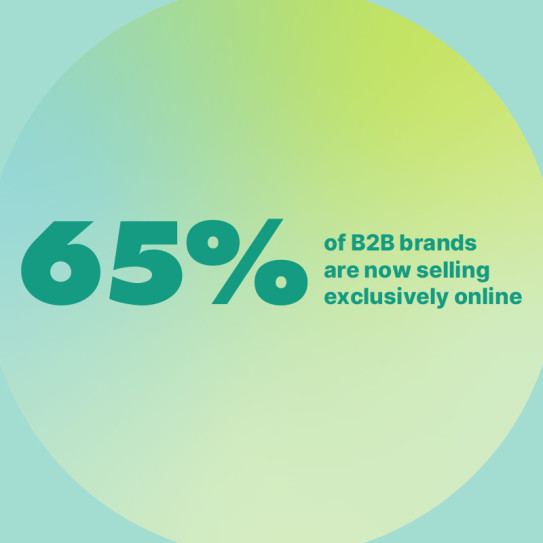
The future of B2B eCommerce today: 5 trends in 2024
From self-serve to Marketplaces, SQLI looks at the key trends shaping the landscape for digital B2B merchants.
When faced with changing customer behaviour and expectations, the online B2C sector responded by transforming the landscape through personalised experiences, frictionless checkouts and omnichannel excellence.
At the time, B2B merchants initially had little motivation to follow suit. Complex customer journeys comprising of inter-connecting product-lines, contracts and renewal processes, led to a reluctance to change long-standing practices and systems that had proven effective for many years. A mix of in-person and telesales, held together by functional, if dated, tech stacks, did enough to drive sales and success.
However, the story has moved on. B2B customers, who are used to fast, streamlined digital processes in every-day life, want the same service and response from B2B brands. McKinsey & Company found nearly two-thirds of buyers preferred digital or remote engagement when given a choice, with eCommerce moving ahead of in-person as the most effective sales channel.
Buyers want to compare products and prices quickly in one place. They expect personalised journeys powered by AI to make suggestions and help them find what they need, quicker. They look for self-serve options with frictionless checkouts offering many different payment methods. And they want to shop and make purchases across multiple channels, seamlessly.
Those B2B merchants who have already adapted, are proving that it is possible to find a balance between the old and the new; the traditional ways of doing business but with new digital processes and systems put in place and driving them on.
Here, SQLI looks at some of the current B2B trends that are shaping the industry.
Ensure a strong digital backbone
Many B2B merchants have invested time and money expanding their product-lines and on their sales and marketing avenues, often overlooking the development of their digital operations.
B2B brands must align with buyer expectations across various channels such as marketplaces, social commerce, face-to-face interactions, distributors, and self-serve portals. This involves reshaping the traditional sales channels and customer experiences across every touchpoint of the buying and selling journey.
This presents a significant challenge for B2B brands, given the complexity of the buying/selling process and the difficulties posed by inflexible and disjointed legacy systems.
In response, many B2Bs are deploying a robust, modern technology backbone to scale digital efforts. This goes beyond merely adopting a new eCommerce platform. In many cases it includes a combination of data/AI platforms, APIs, cloud services and the strategic use of foundational and digital platforms to unify operations, streamline processes and boost revenue from digital channels.
Today’s B2B customers want to switch seamlessly between digital self-service, digitally enabled human interactions and offline engagements. Merchants should prioritise building omnichannel solutions that cater for all needs, across all channels.
Make the most of marketplaces
Marketplaces may have been around in various forms for a long time, but there has been a recent surge in specialised marketplaces within the B2B sector and they are now one of the quickest growing sales channels in B2B.
These platforms offer a centralised digital ecosystem for B2B businesses to connect, discover, negotiate, and transact with a range of suppliers and customers.
According to a survey by Forrester Research Inc., more than a quarter of B2B buyers do at least half of their purchasing on marketplaces.
Establishing a marketplace can be a sound strategic move for businesses looking to expand their market presence, improve efficiencies across the business, and tap into new customer segments and revenue opportunities.

The foundation lies in building trust with buyers and sellers - this is where traditional relationships and work practices are so important. Equally, prioritising digital excellence and long-term value over short-term wins and making the customer experience integral to your plans is essential.
A well-designed marketplace with advanced features like real-time inventory tracking, secure payment gateways, and automated order processing, can improve business operations, reduce costs, and generate valuable data and insights through analytics. This data can help monitor buyer behaviour, gain a deeper understanding of market trends and customer preferences, and identify product/service demand.
Of course, there are Marketplaces that exist such as Amazon Business and Alibaba, and there are benefits from having an established audience. Other B2B’s may prioritise control and customisation offered through a bespoke built marketplace.
Cut out the middlemen with self-serve
The long-accepted way of buying and selling in the B2B sphere with face-to-face appointments has its place, but an increasing number of brands - 65 per cent - are selling exclusively online.
Many customers now prefer to explore their options and make purchases, without the need for human interaction.
Self-serve portals can provide this flexibility, although this doesn’t mean they should stop offering human support all together. Merchants must ask themselves whether their customers can log in easily, manage their own orders and self-serve quickly through a frictionless checkout process. If the answer is no, it might be time to act.
Pete Youell, SQLI Group CTO, said: “There’s a significant trend towards self-serve portals at present. Yet, some merchants express concerns about potential knowledge gaps for customers if they go down this route. There’s a real shortage of ‘communities’ to plug these gaps in the B2B sector.
“I believe there’s value in building-out shared-knowledge bases, content hubs, areas where customers can ask a question and learn about products, leave reviews and so on.
“If the transformation process is done correctly, it will lead to greater customer satisfaction and loyalty, but also increased sales and better engagement. Self-serve is not about leaving the customer to get on with it, it’s about servicing the customer in a different and better way.”
For those B2B merchants who are currently not using their data effectively, this might seem like a lot to take on board. Integrating Incorporating data analysis platforms like Adobe Analytics into digital systems can simplify processes, gather data from various channels, and provide insights into high-value conversion paths such as bookings, leads or subscriptions. This facilitates real-time understanding through detailed reports, empowering teams to allocate resources in the right areas.
Pete Youell, SQLI Group CTO: “There's so much data to collect and it sits in so many different places that most businesses don’t have a strategy or the right technology to manage and make the most of it.
“B2B merchants need to invest more in data projects for better decision-making and personalised customer experiences. Unlocking the potential of business data can cut costs, enhance efficiency, and improve overall customer experience."
Let AI ease the burden and help drive sales
From improving search functionality, to personalised content, AI is enhancing all aspects of the digital experience and customer journey.
Live Chat is one area that has quickly become an important tool for B2B merchants. Chatbot software can lessen the burden on customer service operatives, helping answer queries quickly, 24/7 across multiple channels. With AI integration, it can do so much more, including reading, analysing customer behaviour, and providing personalised offers to customers. These can be followed up by your sales teams at a later date, generating new leads and improving the customer experience. AI can also address more complicated customer service issues, automatically processing refunds and helping reduce your customer service hours.
Market intelligence and information technology group International Data Corporation, predicts more B2B companies will use AI to deliver deeply personalised journey engagement by 2026 – leading to a 40 per cent drop in marketing and sales human touch points.

Personalised product recommendations can fill the gap, with AI taking data from past customer behaviour and purchase history to make suggestions and help customers find what they want quicker. AI-powered features like ‘customers also viewed’ can suggest products based on brand, size, colour or more, bringing with it a whole new layer of convenience to buyers.
The final word
While a few steps behind B2C, the online B2B industry has woken up to the importance of digital processes and systems.
Companies should prioritise digital investments in two areas. Firstly, where digital is most valued by customers such as such as facilitating swift purchases and repurchases, providing online tools for customer service, and presenting real-time pricing through product configurators.
Secondly, where digital solutions can empower human interactions with customers, especially in situations where a human approach is essential for a more effective customer experience.
With buyers increasingly expecting quicker, easier transactions online, it’s vital to act or lose out to brands that go the extra mile. This means creating multiple sales channels, including self-serve portals and marketplaces, to streamline the time it takes customers to compare products and prices, and offering easy online payment solutions.
This doesn’t mean dismantling years of tradition, in many instances it means finding a balance between the old and the new; a seamless digital experience and human interaction, even if the latter is digitally facilitated. This could mean rejuvenating work practices by integrating AI and data management processes to increase efficiencies, overall customer satisfaction, and create new leads. Importantly, it needs to work hand-in-hand with the workforce to increase data-driven decisions.
While this might sound like a complex undertaking, digital experience experts such as SQLI - with success in shaping the strategies and digital systems of some of the biggest B2C and B2B brands – are on hand to put you on the right path and guide you through your own digital journey.





